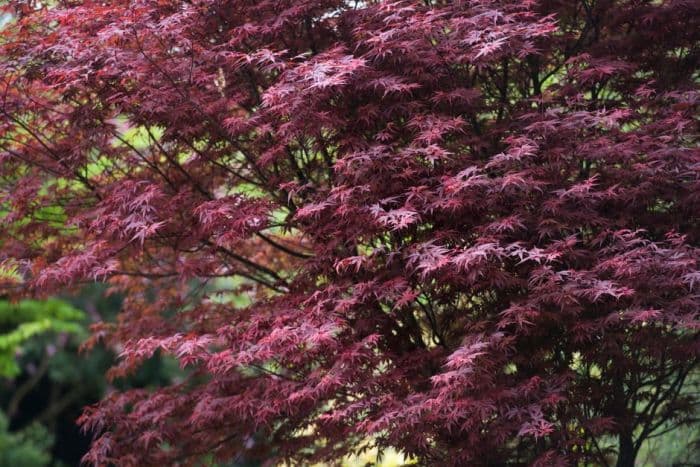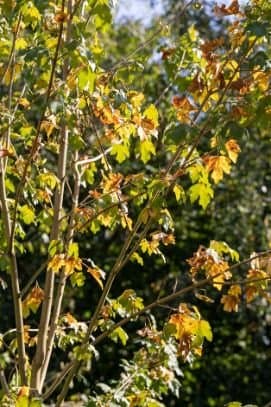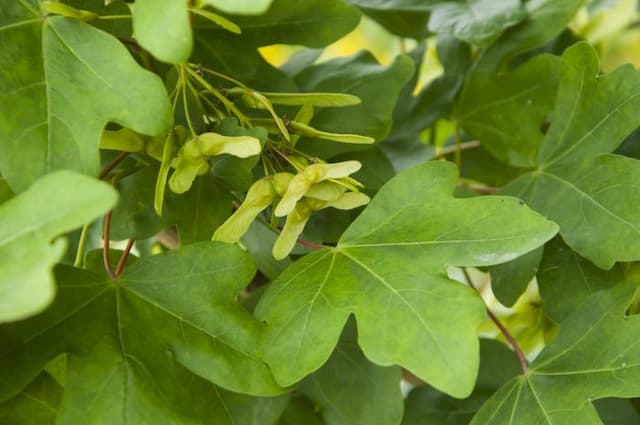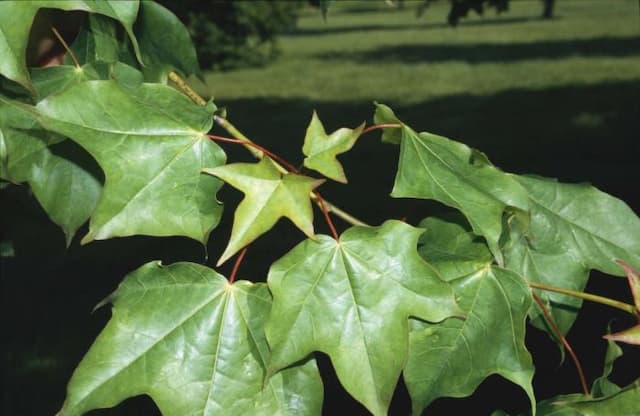Japanese maple Acer palmatum 'Sumi-nagashi' (M)

ABOUT
The Japanese maple known as 'Sumi-nagashi' is a stunning ornamental plant with a distinctive appearance. It has a graceful, rounded to upright canopy that is recognizable for its striking leaves. The foliage undergoes a remarkable transformation throughout the seasons. During spring, the leaves emerge in a rich shade of purple-red, and as they mature, they exhibit beautiful deep, maroon tones. The leaves themselves are sharply pointed with a palmate, almost lace-like form, giving them an intricate and delicate look that echoes the fine art of paper cutting. As autumn appears, the leaves of 'Sumi-nagashi' take on spectacular new hues. They transition to a dynamic range of colors including crimson, scarlet, and sometimes golden oranges, providing a vivid display that contrasts well with the changing colors of the fall garden. The leaves are typically five-lobed, and the deep cuts between the lobes add to the plant's elegant texture. Bark and branches are equally appealing, with a smooth, gray bark that provides winter interest. The branches are layered, contributing to the plant's overall graceful structure, which often has an artistic, almost sculptural quality to it. Blooms are not particularly showy on this cultivar, as it is mostly appreciated for its foliage and structural beauty. Overall, the 'Sumi-nagashi' Japanese maple is appreciated for its gorgeous foliage that changes with the seasons, offering a rich tapestry of colors that enhance the aesthetics of gardens and landscape designs.
About this plant
 Names
NamesFamily
Sapindaceae
Synonyms
Japanese Maple, Red Laceleaf Maple, Sumi-nagashi Maple
Common names
Acer palmatum 'Sumi-nagashi'
 Toxicity
ToxicityTo humans
Japanese Maple is not considered toxic to humans. It is generally recognized as safe to have in a landscape where people, including children, are present. There is no significant risk of poisoning or symptoms associated with ingesting parts of the Japanese Maple. As with any plant, consuming parts not typically identified for consumption should be avoided due to the potential for choking or allergic reactions, but toxicity is not a concern with this species.
To pets
Japanese Maple is also not known to be toxic to pets. It is not listed among plants that pose a significant risk of poisoning to domestic animals. Therefore, if pets were to ingest leaves or other parts of the Japanese Maple, they are unlikely to suffer from any serious toxic effects. However, overconsumption of any non-food material could potentially cause gastrointestinal upset or blockage in pets, so it's still best to prevent them from eating large quantities of plant material.
 Characteristics
CharacteristicsLife cycle
Perennials
Foliage type
Deciduous
Color of leaves
Mixed
Height
10-15 feet (3-4.5 meters)
Spread
10 feet (3 meters)
Plant type
Tree
Hardiness zones
5-8
Native area
Japan
Benefits
 General Benefits
General Benefits- Attractive foliage: The Japanese Maple is known for its beautiful, deeply cut, red or purple leaves that offer aesthetic appeal throughout the growing season.
- Seasonal color change: The leaves change colors with the seasons, providing a dynamic display of hues from spring to fall.
- Shade provision: As the Japanese Maple matures, it creates shade in gardens, offering a cool spot during hot days.
- Compact size: Due to its moderate size, the Japanese Maple is suitable for smaller gardens or spaces that cannot accommodate larger trees.
- Landscape versatility: This tree can be used in a variety of landscape designs, from traditional to contemporary, and can be planted in mixed borders, as a specimen, or in containers.
- Low maintenance: The Japanese Maple generally requires minimal pruning and upkeep once established, making it an ideal choice for gardeners of all skill levels.
- Habitat support: Though not a primary food source, the tree provides habitat and shelter for various bird and insect species.
- Increases property value: Attractive and well-maintained landscaping with feature trees like the Japanese Maple can enhance the value and curb appeal of a property.
- Cultural significance: Known for its origin in Japanese gardening and symbolism, the Japanese Maple is often associated with peace and serenity, making it a great choice for creating a tranquil garden setting.
 Medical Properties
Medical PropertiesThis plant is not used for medical purposes.
 Air-purifying Qualities
Air-purifying QualitiesThis plant is not specifically known for air purifying qualities.
 Other Uses
Other Uses- Photography and Art Inspiration: The distinct red-purple leaves of the Japanese Maple can provide stunning visual inspiration for artists and photographers, particularly in the fall season when the foliage changes color.
- Bonsai: Due to its graceful form and adaptability, the Japanese Maple is a popular choice for the Japanese art of bonsai, and it can be trained into miniature landscapes.
- Cultural Symbolism: In Japanese culture, the Japanese Maple can be used to symbolize peace, serenity, and the beauty of nature, and it's often found in traditional Japanese gardens for this purpose.
- Culinary Decoration: While not a common use, the leaves of the Japanese Maple, particularly in their vibrant autumnal state, can be used as a natural garnish to decorate plates or dishes for special culinary presentations.
- Educational Resource: This plant can be used in botanical studies and educational programs to demonstrate principles of plant growth, pruning, and horticulture, particularly in temperate regions.
- Hobby Crafting: The wood from pruned branches can be used for small hobby crafts, such as making jewelry, decorative ornaments, or even small woodworking projects.
- Aquascaping: Enthusiasts of fishkeeping and aquascaping can use trimmed branches from the Japanese Maple to create naturalistic underwater landscapes in aquariums.
- Plant Collecting: With its attractive appearance and many cultivars, the Japanese Maple is a prized specimen for plant collectors and enthusiasts seeking to diversify their garden with unique varieties.
- Seasonal Festivities: In regions where the Japanese Maple is part of the local flora, its leaves can be incorporated into seasonal decor, such as autumn wreaths or table settings.
- Outdoor Meditation Spaces: The serene appearance of the Japanese Maple makes it an excellent choice for creating tranquil meditation or yoga spaces in outdoor gardens.
Interesting Facts
 Feng Shui
Feng ShuiThe Japanese Maple is used in Feng Shui to enhance the beauty and balance within a garden, as its delicate leaves and the often vivid colors can evoke feelings of calmness and relaxation. It is ideal for creating a focal point to harness energy (Chi) in a space that seeks to promote a sense of well-being and harmony. Planting a Japanese Maple in the East for health and family or Southeast for wealth and abundance can be beneficial according to Feng Shui principles.
 Zodiac Sign Compitability
Zodiac Sign CompitabilityThe Japanese Maple is not used in astrology practice.
 Plant Symbolism
Plant Symbolism- Beauty and Elegance: The Acer palmatum 'Sumi-nagashi', commonly known as the Japanese Maple, is highly regarded for its ornamental beauty and the elegance of its leaves, which symbolize aesthetic and visual pleasure.
- Peace and Tranquility: The serene growth habit and the soothing change of colors in the Japanese Maple's foliage throughout the seasons convey a sense of calm and peacefulness.
- Endurance and Patience: Japanese Maples can live for many years, some over a century, representing endurance, patience, and the passage of time.
- Graceful Adaptation: With its ability to adapt to different climates and conditions, the Japanese Maple is a symbol for gracefulness and flexibility in the face of change.
- Balance and Harmony: The symmetrical shape and balanced branching of the Japanese Maple stand for harmony in nature, encouraging a balanced approach to life.
 Water
WaterThe Japanese Maple 'Sumi-nagashi' prefers consistent moisture, so it's important to water it deeply and regularly during dry spells. Aim for about 1 inch of water per week, either from rainfall or manual watering. In hotter summer months, you may need to water once or twice a week, ensuring you provide a total of approximately 1.5 to 2 gallons for a young tree each time, depending on the size and soil conditions. Decrease watering during the fall and winter when the tree is dormant. Avoid overwatering, as this can lead to root rot.
 Light
LightJapanese Maples, including 'Sumi-nagashi', thrive in locations that offer full to partial sunlight. They need at least 4 hours of direct sunlight each day, but in regions with very hot summers, they benefit from some afternoon shade. Position your 'Sumi-nagashi' in a spot where morning light is plentiful and direct afternoon light is filtered to prevent leaf scorch.
 Temperature
TemperatureJapanese Maple 'Sumi-nagashi' can tolerate a range of temperatures but performs best in conditions between 60°F and 80°F. It can withstand brief periods of colder weather down to 20°F and should be protected from extreme heat above 90°F. Ideal growing conditions will prevent heat stress and cold damage to the plant.
 Pruning
PruningPrune the 'Sumi-nagashi' Japanese Maple in late winter before the spring growth starts to remove dead or crossing branches and to maintain its shape. Thinning out the canopy every few years encourages better air circulation and light penetration. Prune sparingly to maintain its natural form; excessive pruning can harm the tree's health and aesthetics.
 Cleaning
CleaningAs needed
 Soil
SoilThe Japanese Maple 'Sumi-nagashi' prefers moist, well-draining soil that is rich in organic matter. A mix of loamy soil, peat, and pine bark is beneficial. The soil pH should be slightly acidic to neutral, ranging from 5.5 to 7.0 for optimal growth.
 Repotting
RepottingJapanese Maples like 'Sumi-nagashi' should generally be repotted every two to three years. It's best to repot in the late winter or early spring before the sap starts to flow and buds swell.
 Humidity & Misting
Humidity & MistingJapanese Maple 'Sumi-nagashi' prefers moderate humidity levels. Although they can adapt to different humidity conditions outdoors, they flourish best in an environment that mimics their natural forest habitat.
 Suitable locations
Suitable locationsIndoor
Ensure bright, indirect light and shield from hot sun.
Outdoor
Partial shade location; protect from harsh conditions.
Hardiness zone
5-9 USDA
 Life cycle
Life cycleAcer palmatum 'Sumi-nagashi', commonly known as the Red Japanese Maple, begins its life cycle with seed germination, a process that can span several weeks to months due to seed dormancy that requires stratification to break. Once the seeds sprout, the seedlings grow into juvenile saplings, featuring the species’ characteristic reddish-purple foliage which is sensitive to environmental conditions such as light and temperature. As the sapling matures, it undergoes primary growth, developing a strong root system and branching structure. During secondary growth, the tree gains girth and height, and can reach its mature size within 15-20 years, depending on conditions. Throughout its maturity, the Red Japanese Maple experiences cycles of foliage growth in the spring, followed by leaf maturation and deepening coloration in summer; autumn brings vibrant color changes before leaf abscission. This deciduous tree can live for several decades, with some specimens known to reach a century, after which the tree will decline and eventually die, completing its life cycle.
 Propogation
PropogationPropogation time
Early Spring
The Japanese Maple 'Sumi-nagashi' is commonly propagated by grafting, which is by far the most popular method due to the fidelity of the offspring to the parent plant. This technique involves taking a small branch or bud from the 'Sumi-nagashi' and joining it to a rootstock of another, often more vigorous, maple species. The best time for grafting is typically in late winter or early spring, before the sap starts to flow and buds begin to swell. Grafting requires precise cuts on both the scion, which is the piece from the 'Sumi-nagashi', and the rootstock to ensure a close fit that will promote successful union and sap flow between the two. The join is then securely bound and sealed to prevent desiccation and disease while the graft heals, a process which can take several weeks to months depending on conditions such as temperature and humidity.







![Freeman maple [Autumn Blaze]](/_next/image?url=https%3A%2F%2Fplants-admin.emdemapps.com%2Fimages%2Fplants%2F%2Fimages%2F604b575b84d87.png&w=640&q=75)

